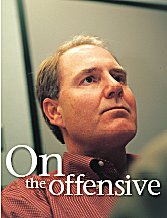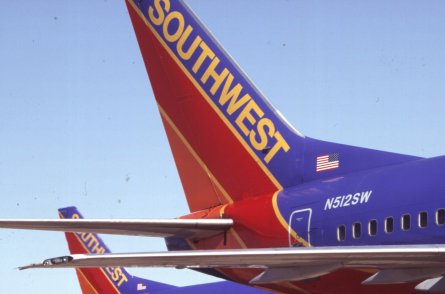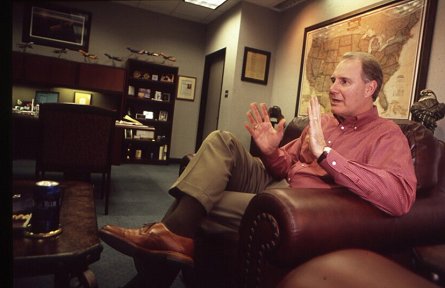By David Field in Dallas Photography by Etienne de Malglaive
Gary Kelly has a hard act to follow, but looks like the right man to grow Southwest Airlines – that much-imitated low-cost leader – aggressively and head off the competition
Talk about Southwest Airlines and the conversation ends up focusing on Herb Kelleher. That is how strongly the trailblazing discount carrier and its equally legendary co-founder and long-time leader are identified, linked by Kelleher’s famous, or perhaps infamous, personality and humour. But Herb has left the building and has yielded the reins of daily control.
 In Kelleher’s seat as chief executive now sits the quiet, conservative, soft-spoken former chartered accountant Gary Kelly, who is the first to admit that he is no Herb Kelleher. And that is very much the point of Kelly’s role in Southwest’s evolution: it no longer needs an outsized personality as its brand, because the airline has outgrown any one individual and has developed its own strong personality, one of humour and warmth and one that is expressed by and through all Southwest’s people, not just Southwest executives.
In Kelleher’s seat as chief executive now sits the quiet, conservative, soft-spoken former chartered accountant Gary Kelly, who is the first to admit that he is no Herb Kelleher. And that is very much the point of Kelly’s role in Southwest’s evolution: it no longer needs an outsized personality as its brand, because the airline has outgrown any one individual and has developed its own strong personality, one of humour and warmth and one that is expressed by and through all Southwest’s people, not just Southwest executives.
Kelly is aware that Southwest has a tremendous competitive advantage – it carries more domestic passengers annually than any other US carrier – but only so much time to grow and solidify that advantage. The crucial edge Southwest has over other airlines is its strong fuel hedging strategy, which Kelly shaped in his earlier position as chief financial officer and which has made all the difference. In some periods it has made the difference between operating profit and loss.
But this advantage cannot remain forever and no airline will ever again be able to lock in the kind of low fuel prices that it has enjoyed. The hedges fade over the next five years, and then that window of advantage closes. Meanwhile, other low-cost carriers are growing and even though none, even the strongly successful new players like AirTran or JetBlue Airways, is close to rivalling Southwest, they are showing resilience and strength at the same time that the legacy carriers have cut costs dramatically, both in and out of bankruptcy court protection.
In short, Southwest is no longer the little airline that could; it is the big airline that must. “We’ve bought ourselves time,” Kelly says. “The advantages we have are immense, and shame on us if we squander them.” Kelly’s goal is to keep growth steady, at about 10% annually, so that pre-tax profits stay at slightly higher levels, in the 15% range. Southwest will achieve this by expanding its network. But if this level of growth is relatively modest, Kelly has made Southwest unusually aggressive about it, reflecting his belief that time is not his ally. Since taking over the top spot in summer 2004 after the unexpected resignation of Jim Parker, Kelleher’s designated successor, Kelly has added a new facet to the Southwest persona – an aggressive stance that has put others on guard.
Bold initiatives
Southwest’s 2004 move into the hub of Philadelphia was bold, but Kelly has been beyond bold, with signature initiatives such as taking on the Dallas Love Field restrictions that have limited Southwest since its founding; threatening to leave Seattle-Tacoma airport in the Pacific Northwest over its high costs, and above all moving into a truly redoubtable fortress hub, United Airlines-dominated Denver.
This move into Denver, where flights started in January, is, according to Lehman Brothers analyst Gary Chase, a surprise, but a certain sign that the airline is getting more aggressive. It is different from earlier Southwest moves into big hubs. Philadelphia may have been dominated, but the incumbent was a vulnerable one, US Airways, and Detroit’s Metro, where Northwest Airlines dominates and where Southwest began service in 1987, has never been more than a toehold. But Denver, where United is on the rebound, offers a new challenge. There, Southwest faces a relatively strong legacy carrier at the same time it faces relatively strong low-fares competition – in this case Frontier Airlines.

The assault on the Wright Amendment limits, which Kelly launched just months after his accession, is an unusual break from Southwest’s long-standing position of neutrality on the issue and a somewhat risky one. It threatens the entente cordiale that has characterised the airline’s relationship with its home towns of Dallas and Fort Worth. The rule, named after a former Texas politician Jim Wright, restricts nonstop flights from the Southwest home base of Dallas Love Field to seven nearby states; a last-minute manoeuvre in the Senate added Missouri in December. But from anywhere else in the nation, Love flyers have to change aircraft, usually in Houston. Southwest also faces some admittedly bizarre restrictions on how it can market Love flights. It cannot, for instance, display connecting flights to or from Love on its website. Unwilling to take on a home-town battle, the airline had long hewed to “strict agnosticism” on the limits.
Kelly sees little risk of losing the warm public reception of the brand and the name. He explains: “We have always been mavericks, and it is our customers that are the reason why we are doing these things.” Most airline executives talk about customers, but the Southwest culture – a distinct and real atmosphere that flyers and visitors sense, acknowledge and react to – is based on customers. The management structure reflects this: long-time Kelleher confidante Colleen Barrett remains as president and keeper of Southwest’s corporate culture. The architect of its personnel (“chief people officer”) development and selection system, Barrett has stayed in the number-two slot, focusing on staffing at an airline that receives 226,000 job applications a year and employs about 1,700 people. Kelleher, who retains the role of board chairman, has held back from taking a detailed role in everyday doings at Southwest, preferring to focus on presenting the airline to a larger public audience and on public policy issues such as the Wright Amendment.
Kelly does not mind sharing: this is, he says, “a company with many leaders”. Kelly’s point is that leadership comes from more than one central source – a recognition that the airline’s culture drives its people as much as individuals. And Gary, as he is called by all at Southwest, from reservation staff, to clerks tagging bags at check-in counters, to other executives, is in a real sense one among many of the leaders: Herb still plays a role and can be seen roaming the headquarters halls, while Barrett exerts influence in her constant campaign to keep the culture vital. This reflects the company work ethic, one described by Brandeis University business professor Jody Hoffer Gittell as one with few vertical barriers, one based on the power of relationships among employees. Southwest people, motivated as much by culture as by profit sharing, undertake tasks that are not formalised by job descriptions.
So pilots will run down the jetway/airbridge ladder to toss a late-checked bag onto the luggage conveyor while flight attendants will help hustle snacks and drinks from the catering trucks to the aircraft galley. None of these seems an enormous achievement until an observer compares a traditional airline, legacy or low-fare. How many pilots at other airlines would be willing to do a landing apron search for debris while waiting for the flight to approach the gate?
The pilots, Kelly says, “are important leaders at this company”, and late last year, the Southwest Airlines Pilots Association, a union that is independent of the large national ALPA, initiated and agreed to a series of productivity improvements that could save the airline $4 million annually. The pilot deal adds 1.5 hours of flying a month at no added cost by reducing the number of new pilots that need to be recruited. Southwest’s 4,700 pilots fly about 67 “hard” hours a month, and a median wage for a fifth-year first officer (co-pilot) according to AIR, an Atlanta-based pilot career service, is just under $9,300 a month. That is well above the $7,600 industry average for a first officer at that grade, according to AIR. The best thing Southwest can do for its pilots, though, is to grow, Kelly says. “This is a pilots’ airline. They can advance to the left seat, to command, rapidly, and that’s what pilots want – growth.”
Savings drive
The pilot offer came in response to a request that Kelly made of all Southwest people, to come up with ways to save costs. Its solid and immoveable rank as the perceived low-price leader comes from its solid foundations of low costs. The airline’s cost structure has stayed steadily low for the past 12 years as average trip length has nearly doubled, from 495 miles (796km) in 1992 to 793 miles (1,276km) in last year’s third-quarter.

In the second-quarter of 2005, as fuel was in its trajectory, unit costs actually dipped despite the one-fourth increase in fuel costs. Kelly is proud that “over 34 years, we’ve been on a steady improving rate in terms of our employees. We’ve never had furloughs; we’ve never had pay cuts. And our head count per aircraft, as a real gross measure of productivity, is at the lowest level in 25 years. So as long as we find ways to work more efficiently, work smarter, we’ll grow.”
Among these ways are using gate equipment rather than auxiliary power units to cool parked aircraft; tankering and bunkering fuel; and new flight paths including some offshore routeings on north-south coastal flights that will save time; plus the retrofitting of all the airline’s 200-plus Boeing 737-700s with winglets from Aviation Partners/Boeing. New aircraft will be delivered fitted with the winglets. A major campaign for 2006 is increasing punctuality, crucial for an airline that operates over 980,000 trips a year. In the first nine months of 2005, Southwest carried over 66 million customers, while Delta Air Lines, the number two, carried 60.1 million, according to the US Bureau of Transportation Statistics. Southwest is investing in an initiative it calls EFT or Electronic Flight Times, under which information from a ground-to-air datalink will be automated and used globally in both internal, operational and external reporting of flight times and delays. By the end of the year, Southwest internal flight information display and external airport displays will be connected and displayed at airports on new liquid crystal display flat panel monitors. The airline has also invested about $12 million over the past three years to speed the boarding process with an automated boarding-pass system developed with another Texas-based low-cost leader, Dell Computers.
Healthy margins
Most other airline executives would give up annual bonuses to have Kelly’s problem, which, as he puts it simply, is this: “We have more growth opportunities than we have airplanes.” Kelly’s main worry is not so much keeping up the string of profitable quarters – Southwest has now accumulated more than 58 quarters and 32 years of consecutive profits. It is in keeping margins healthy. He would like a 15% return on invested capital, up from 8.8% through the first nine months of 2005.
This growth will not be achieved through merger or acquisition, Kelly insists. The airline’s codesharing deal with bankrupt ATA Airlines may have been “pure joy”, he says, but will not be repeated. It is growth that will be driven by a steady flow of 737-700 deliveries through 2012. With 91 firm orders and with both options and purchase rights, the total over these years could, and likely will, reach 350 new aircraft, in addition to the 29 net new aircraft added in 2005 to its 417-strong fleet. “The 737-700 is our future,” Kelly says.
This year, as in most years, bargain-hungry flyers, airports and competing airlines will expend vast amounts of energy trying to guess where Southwest will go next, but Kelly gives few hints. He says that “Denver may be the only new city for us this year”, but hints that Southwest may pick up slack left by ATA Airlines, the bankrupt carrier in which it invested and with which it began a codeshare in late 2004. Southwest announced its Denver plans as ATA announced it was pulling out of the Colorado city, and Kelly notes that Southwest has lost ATA feed from Minneapolis/St Paul and other points. Observers, including Chase at Lehman Brothers, believe Southwest will strengthen East Coast service at points such as Baltimore/Washington International, where, Kelly concedes, the carrier’s yields have been under pressure. Charlotte, a US Airways stronghold, is also high on his list.
Of course, the challenge is growing revenues as well as capacity, but the airline has done a “strong” unit revenue growth, according to Raymond James & Associates analyst James Parker. He thinks that unit revenues rose by as much as 9% in the last months of 2005, above his earlier forecast of 7% growth, with revenue growth of 5% for this year as capacity grows 9% for Southwest (and shrinks 1% for all domestic carriers). As Delta pulls back capacity in the southeast and in particular in Florida, Southwest has been aggressive on fares in a targeted manner, while reducing the number of seats available in the lowest fare buckets and responding to fuel costs with modest ticket price increases. Kelly says: “We want to create value so that customers will pay a little more for their ticket, but not much more than a $1 or $2 increase. We are also tightening up the parameters in Rapid Rewards [the airline’s frequent flyer plan], but you won’t see any radical changes in either the fare structure of the loyalty schemes.” Southwest has room to grow: its load factors are still in the low 70% range, even after late 2005 increases of over 5 percentage points.
Another tool for growth is the internet, through which Southwest sells almost all of its tickets. It was the first airline to set up a home page on the web and in the third-quarter of 2005 more than 65% of the carrier’s revenue came through Southwest.com. The airline has personalised the internet with a feature launched just a year ago – Ding! – the first direct link between an airline and customer desktops. Ding! alerts subscribers to short-term and localised fare sales with an audible and visual alert. About 1 million users have downloaded Ding!, according to Gregory Saks of Compete, a Boston-based online research firm. He estimates that it has driven incremental bookings of more than $60 million annually. Airline Business judges also cited Ding! in their decision to give Southwest the magazine’s 2005 Strategy Award for Marketing.
The Ding! sound is meant to remind users and customers of the on-board chime that alerts passengers to an announcement from the flightdeck, and the sound effect has been part of Southwest’s slogan for several years in radio and television advertisements, which close with the tagline: “Ding! You are now free to move about the country.” Kelly’s growth plan, given the carrier’s prospects and prosperity, may just make that a reality.
Mild but wild Gary Kelly never intended to work for an airline and in fact had not thought much of the industry in his high school and college days. In fact, his first trip on Southwest Airlines did not make him a convert. He recalls that he was on a college football recruiting trip, and flew to Rice University in Houston on Southwest in its first few years of operation. “I remember getting on the plane and seeing that there were only one or two other passengers on board. I said to myself, how can this airline ever expect to stay in business?” But it has, and so has Kelly, rising from controller and financial analyst to chief financial officer and executive vice-president. In the summer of 2004, a boardroom crisis propelled him to the top spot as the chief executive and vice-chairman after the sudden departure of Jim Parker, one of co-founder Herb Kelleher’s anointed successors. Unable to make progress in thorny and protracted flight attendant union contract negotiations, Parker was nudged aside as Kelleher, coming back to day-to-day management at Southwest, took over the contract talks. Parker’s co-leader at Southwest, Colleen Barrett, still works closely with Kelly. Slightly miffed at the label “mild-mannered”, Kelly, who will be 51 in March, has been known to get wild, and at one Southwest Halloween party appeared heavily made up and in a leopard-skin costume as Gene Simmons of the rock band Kiss. Kelly says he does not go that far at home, but does confess to liking Porsche sports cars. |
Click here for more Airline Business interviews
Source: Airline Business























